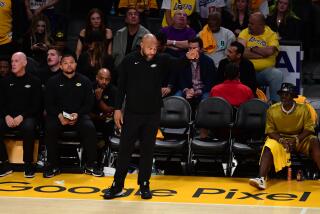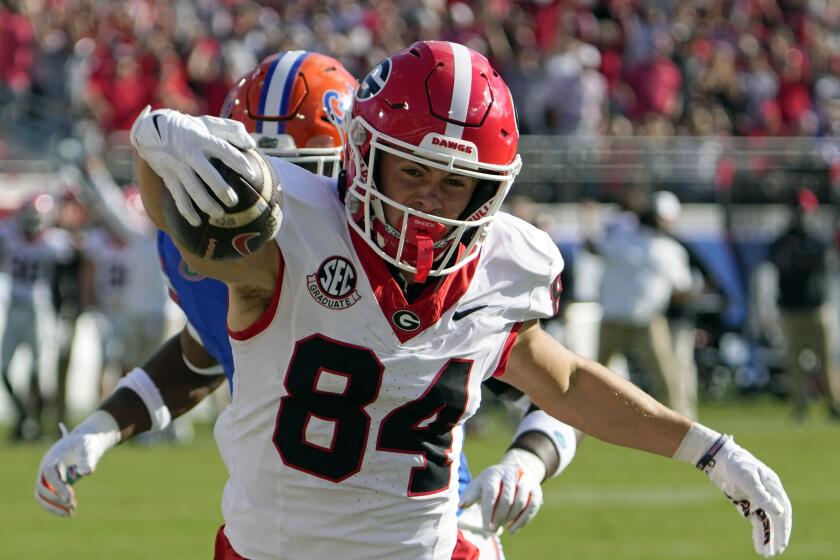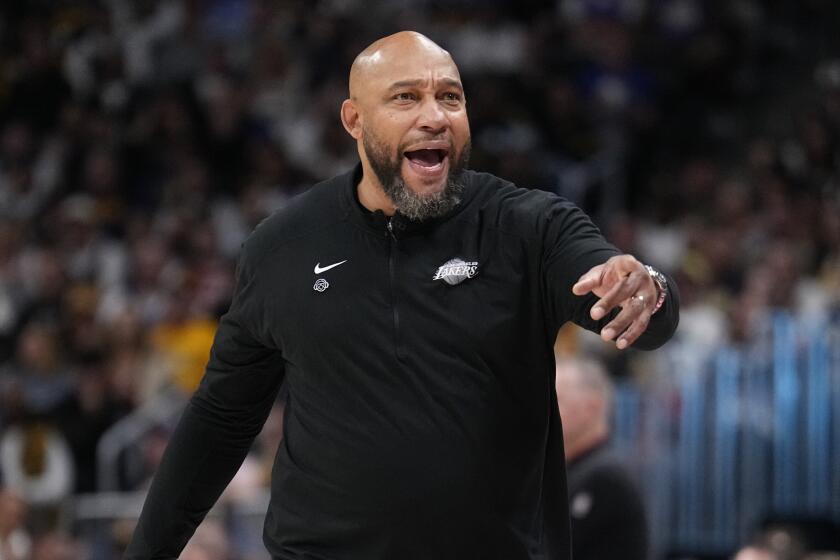Different Wavelength
Bobby Martinez slows his brown Impala and motions toward the street corner where his cousin bled to death after her throat was slit during what he recalls as being a gang fight.
That was 10 years ago, but if you look closely enough, Martinez says, you can still see the bloodstains.
For the record:
12:00 a.m. June 21, 2006 For The Record
Los Angeles Times Wednesday June 21, 2006 Home Edition Main News Part A Page 2 National Desk 1 inches; 38 words Type of Material: Correction
Surfing: A headline on a story of surfer Bobby Martinez in Tuesday’s Sports section incorrectly said that Martinez hopes to be a teacher. The story said that one of Martinez’s friends, Manny Raya, hoped to be a teacher.
Nearby is the sidewalk where his mom “saved a guy’s life” by wrapping her jacket around his head after it was bashed in by a man with a brick, during another fight.
“He didn’t die, but he was messed up,” Martinez recalls, sitting back, one hand on the steering wheel. “He later went to prison up north -- he was arrested for murder or something.”
Welcome to Santa Barbara’s gritty Westside, in proximity to but a world removed from the bustling seaside with its upscale homes, posh resorts, coffeehouses and waterfront eateries.
Here, a largely Latino population struggles to make ends meet. Kids from broken homes learn early to fend for themselves. Some turn to crime. Many turn to gangs.
Almost nobody turns to surfing. But Martinez did, and he became one of the best there is. A rookie on the Assn. of Surfing Professionals’ World Championship Tour, he trails only Kelly Slater in the title race as the tour heads to Mexico this week for the Rip Curl Search, its fifth of 12 events.
Passing the seven-time world champion would be a notable achievement, but in the grand scheme it would merely be another chapter in the much larger saga that is Martinez’s life, a Westside Story playing out something like this ...
Little homie learns to surf and chooses riding waves over gangbanging ... Excels through the amateur ranks like no one before or since and becomes a big-time pro ... Shatters ethnic and cultural barriers and inspires other homies who, with Martinez as their poster child, introduce other young gang members to surfing, one of them says, “to let them be kids again.”
The story starts, naturally, with Martinez, a humble young man with an endearing smile and a love of his neighborhood that has not diminished.
“Bobby is an anomaly in the surf world,” says Evan Slater, editor in chief at Surfing Magazine. “He’s been a time bomb just waiting to explode on the WCT and will quickly fall into company with the top five in the world. Then he’ll return home to his quiet neighborhood in Santa Barbara, completely removed from it all.”
Martinez, 24, who recently became engaged and bought a two-bedroom home about a mile from where he grew up, is an anomaly at home too. Latino children from poor neighborhoods, as a rule, don’t hang out in surfing circles. But Martinez’s parents, Bob and Joanie, took their three kids often and soon realized that a major benefit was that it kept them off the streets.
“We just really liked going to the beach, but his getting into surfing definitely helped,” Bob Martinez, a concrete contractor, said of his son.
“I think it just subconsciously steered him away from the influences on the streets. As he got older there was a lot of peer pressure, and he took a lot of flak for being a surfer boy instead of being affiliated with a gang, but he always had that to fall back to.”
Bobby was standing on a bodyboard by 5. He received a surfboard for Christmas the next year. When he was 8 or 9, he informed his dad and sister, while walking to school, that he was going to be a pro surfer. “And they just laughed at me because it was so different,” Martinez recalls.
Martinez led two lives: one in the neighborhood and one at local surfing spots such as Rincon, a legendary right-handed point break where Martinez honed his technique. He played basketball and soccer at the Westside Boys’ Club and adjacent Bohnett Park. Gang fights were so common that police opened a substation there. Somehow, Martinez, his brother, Jesse, and his sister, Crystal, remained “neutral.”
“I was just lucky to have someone to take me to the beach and stuff, because it would have been easy to fall into the gangs because everybody else did,” says Martinez, while approaching the corner where his cousin was killed. “My other family members have fallen into gangs. I was just lucky.”
Janelle Williams, his cousin, was 17, a member of the Night Owl gang and a proud defender of all things Westside. It was an early Saturday evening when the fight went down. Strangers had entered the neighborhood, and tensions rose.
“All I know is, one thing led to another and they started fighting,” Martinez recalls, quietly. “And then a guy ended up ... cutting her in the neck and she bled to death from the jugular or whatever, right on the corner.”
Martinez was 13 at the time and says the memory of that evening, of grief-stricken family members at the hospital and of the ensuing funeral, is still vivid.
“There were so many homies from the Westside. It was packed. The funeral was crazy,” he continues, shaking his head. “She lived life quick, and that was the route she ended up taking. But she was a nut. She loved her neighborhood, that’s for sure.”
Lt. Paul McCaffrey of the Santa Barbara Police Department, then a sergeant assigned to the case, said Williams -- whom he described as “a big girl” with a penchant for fighting -- initiated the brawl by demanding beer from the strangers, who McCaffrey said were not known gang members.
When the fighting began, Williams had gotten on top of one of the men and was “pounding him” when one of the beer bottles broke. The man reached for the broken bottle and used it to slash her throat. He fled with the others but later turned himself in and explained that he was merely trying to defend himself. He was not prosecuted.
Martinez missed a National Scholastic Surfing Assn. contest the next morning and says the death of his cousin was “a serious reality call.” He spent more time at the beach and stopped playing other sports.
Two years earlier, in 1994, he had won his first NSSA national championship. He would add six others -- his seven titles are still a record -- before turning pro in 2000 as a competitor on the ASP’s World Qualifying Series tour, an often grueling springboard to the WCT.
Martinez was fast and stylish. The surf media billed him as a future world champion, the best surfer to come out of Santa Barbara since the legendary Tom Curren and heir apparent to Slater.
Martinez set out with high hopes, while his homies struggled through what seemed hopeless lives. One was Manny “Fozzy” Raya, a gangbanger who was kicked out of high school, was arrested often and ultimately was slapped with a felony weapons charge. He was resigned to life behind bars until experiencing a life-changing event.
Raya, who had passed a high school equivalency test, enrolled at Santa Barbara City College to try to impress the court. But while in a philosophy class he read Plato’s “Allegory of the Cave,” in which a prisoner of the cave, who saw only shadows, is released, encounters a wonderful new world and wants to share that world with those still imprisoned.
Although in the allegory, the prisoners don’t want to hear the freed one, Raya likened his neighborhood to the cave. “All of a sudden I wanted to try different stuff,” he says.
Like Martinez, he found surfing, and says he hasn’t been in trouble since. He graduated from UC Santa Barbara on Sunday and hopes to become a teacher. He and J.J. “Taz” Ortiz, another former gangbanger he met at school, founded the Homies Turf 2 Surf camp for kids nominated through the Santa Barbara County Probation Department.
The children, who are on probation for crimes ranging from substance abuse to violent theft, are outfitted with trunks and sandals, shown surf videos and taken to the beach and taught to surf. Martinez, when he is available, gives them pointers.
“They come in as little baldheaded thugs with their arms all crossed, looking mean, but not even a week into the thing they’re playing in the tide pools and acting like little kids,” Raya says. “They also get to go to Huntington Beach to see Bobby compete at the U.S. Open, and what they see is that Bobby is one of us -- a baldheaded Mexican out of the Westside.”
Martin Conoley, a probation officer, says the effectiveness of the program is difficult to gauge, that some boys who have been successfully involved in the camp eventually returned to the streets. But he adds that having caring mentors and putting troubled kids in a fun environment “has been found to be a contributor to a positive outcome.”
Martinez is proof of that, although when surfing becomes work it’s not always fun. The qualifying series circuit is no glamour tour. The big contests draw hundreds, and competition is fierce. Days are long and lonely -- or painfully short. Twice Martinez flew 22 hours to South Africa, lost his first heat and flew home the next day. Sponsors always want more for their money.
Unable to crack the big time, Martinez decided that 2005 would be his last season. He won a five-star event in Brazil, but then suffered an ankle injury and had a falling out with Oakley, his sponsor. Paying his own way and sensing the urgency of his situation, he flourished with a third- and first-place finish to close the season with easily enough points to make the 2006 WCT.
Now a Reef-sponsored rider with a five-year contract and six-figure salary, and with a WCT victory already under his belt, Martinez seems on easy street. Relaxing behind the wheel and gazing out the window, he points out the apartment where he grew up, the duplex where his parents live, the low-income “projects” managed by his cousin and many of his childhood hangouts.
Old memories begin to stir. Surfing, it’s clear, is the last thing on his mind.
More to Read
Get our high school sports newsletter
Prep Rally is devoted to the SoCal high school sports experience, bringing you scores, stories and a behind-the-scenes look at what makes prep sports so popular.
You may occasionally receive promotional content from the Los Angeles Times.






